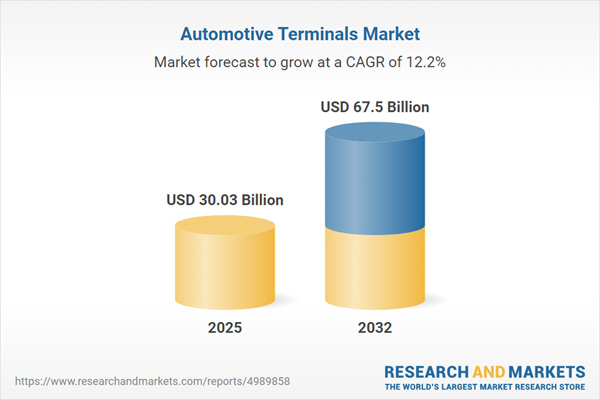Speak directly to the analyst to clarify any post sales queries you may have.
The automotive terminals market is experiencing rapid transformation, powered by technological innovation, regulatory pressures, and evolving industry requirements. Senior decision-makers need targeted insights to support resilient, future-ready strategies for growth and competitiveness.
Market Snapshot: Automotive Terminals Market Size and Growth
The Automotive Terminals Market grew from USD 26.78 billion in 2024 to USD 30.03 billion in 2025. It is expected to continue growing at a CAGR of 12.24%, reaching USD 67.50 billion by 2032. This robust trajectory underscores increasing demand for advanced connection solutions driven by electrification, digitalization, and evolving vehicle architectures.
Scope & Segmentation
This report delivers focused analysis for decision-makers seeking detailed intelligence on product innovations, end-use trends, and competitive dynamics. Coverage spans all major sub-segments, geographic regions, and emerging technological applications relevant to automotive terminals.
- Product Types: Bullet terminals, butt connectors, pin terminals, quick disconnect terminals, ring terminals, screw terminals, spade terminals.
- Vehicle Types: Heavy commercial vehicles, light commercial vehicles, hatchbacks, sedans, SUVs.
- Applications: Battery and charging systems, body control and interiors, infotainment systems, lighting systems, navigation and telematics, powertrain systems, safety and security systems, wiring harnesses.
- Distribution Channels: Aftermarket, OEM.
- Regions: North America (United States, Canada, Mexico), Latin America (Brazil, Argentina, Chile, Colombia, Peru), Europe (United Kingdom, Germany, France, Russia, Italy, Spain, Netherlands, Sweden, Poland, Switzerland), Middle East (United Arab Emirates, Saudi Arabia, Qatar, Turkey, Israel), Africa (South Africa, Nigeria, Egypt, Kenya), Asia-Pacific (China, India, Japan, Australia, South Korea, Indonesia, Thailand, Malaysia, Singapore, Taiwan).
- Key Companies: TE Connectivity Ltd., Aptiv PLC, Yazaki Corporation, Sumitomo Electric Industries, Ltd., Amphenol Corporation, Lear Corporation, Molex LLC, Panasonic Corporation, Japan Aviation Electronics Industry, Ltd., Fujikura Ltd.
Key Takeaways
- Automotive terminals now serve as enablers for safety-critical systems, high-speed connectivity, and stable power distribution, reflecting new vehicle designs and stricter standards.
- Growth in electrification and autonomous driving accelerates demand for terminals that handle higher currents and rapid data transmission without compromising reliability.
- Manufacturers are shifting from traditional metal alloys to advanced composites and sustainable coatings, driven by both regulatory and lifecycle considerations.
- Standardization and interoperability are top priorities, ensuring terminals perform consistently across diverse regional vehicle architectures.
- Partnerships between connector, semiconductor, and materials firms are shaping next-generation terminals with embedded sensors for predictive monitoring and diagnostics.
- Regional demand patterns vary, with Asia-Pacific leading production scale, Europe advancing with regulatory-driven innovation, and the Americas focusing on electrification and legacy vehicle support.
Tariff Impact on the Automotive Terminals Market
The introduction of new tariffs in the United States has impacted sourcing strategies for terminals, resulting in rising costs and a shift toward nearshoring or broadening supply bases. Suppliers are revising inventory management and pursuing localized production to optimize tariff exposure. These changes underscore the importance of resilient supply chain structures and real-time risk analysis across markets.
Methodology & Data Sources
Research is grounded in multi-source approaches, including direct interviews with OEM and supplier executives, extensive analysis of industry standards, patents, and peer-reviewed publications. Robust data triangulation ensures insights are comprehensive, reliable, and actionable for strategic planning.
Why This Report Matters
- Empowers senior leaders with segmented intelligence to benchmark product portfolios and sourcing strategies against evolving industry standards.
- Highlights critical regional and technological opportunities to guide investments in R&D, partnerships, and new market entry.
- Provides actionable recommendations to navigate regulatory shifts and capitalize on supply chain modernization.
Conclusion
This report synthesizes essential insights for stakeholders aiming to strengthen market position in automotive terminals. Strategic focus, innovation, and agile responses to regulatory and supply chain change will define long-term success in this dynamic sector.
Additional Product Information:
- Purchase of this report includes 1 year online access with quarterly updates.
- This report can be updated on request. Please contact our Customer Experience team using the Ask a Question widget on our website.
Table of Contents
3. Executive Summary
4. Market Overview
7. Cumulative Impact of Artificial Intelligence 2025
Companies Mentioned
The companies profiled in this Automotive Terminals market report include:- TE Connectivity Ltd.
- Aptiv PLC
- Yazaki Corporation
- Sumitomo Electric Industries, Ltd.
- Amphenol Corporation
- Lear Corporation
- Molex LLC
- Panasonic Corporation
- Japan Aviation Electronics Industry, Ltd.
- Fujikura Ltd.
Table Information
| Report Attribute | Details |
|---|---|
| No. of Pages | 193 |
| Published | October 2025 |
| Forecast Period | 2025 - 2032 |
| Estimated Market Value ( USD | $ 30.03 Billion |
| Forecasted Market Value ( USD | $ 67.5 Billion |
| Compound Annual Growth Rate | 12.2% |
| Regions Covered | Global |
| No. of Companies Mentioned | 11 |









